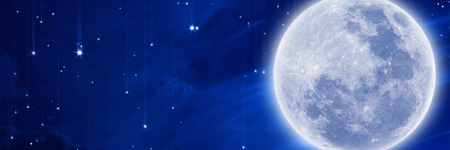What kind of influence does the Moon have on us as humans?
The moon's gravitational pull and its changing phases have subtle yet profound effects on Earth and its inhabitants. From influencing tides to potentially impacting sleep patterns and mood, the moon's presence plays a role in various aspects of human life. Here's what it's thought to do;
The Moon's influence on our hair 💇♀️
Lunar cycles have a direct influence on hair regrowth, which is why it is important to choose the right Moon phase to wax or shave. The ideal time to shave or wax is during the Waning Moon phase, which is the phase in between the Full Moon and the beginning of the New Moon. This is the best time to ensure slower and less visible regrowth. Equally, it's essential to pay attention to the lunar phases when it comes to your hair as well. Depending on which phase the satellite is in, your hair will grow back at a different rate.
Moon's Influence on your libido ❤️🔥
For years, this lunar star has intrigued and fascinated us. Its power of attraction is not only found on the tides, but also on our sexual drive. The Full Moon period awakens passion and physical attraction. During this phase you feel more energetic and emotionally strong, plus, if you are single it could definitely be the best phase to find a partner. It is therefore evident that the Moon has a strong influence on our sexuality.
Moon's influence on your sleep quality 🛌🏾
It's official, according to some studies the Full Moon can cause insomnia and alters our sleep rhythm. In fact, it has been shown that during certain phases of the Moon, we take longer to drift off to sleep. Melatonin; the hormone that regulates sleep patterns, decreases considerably during the Full Moon phase.
How does the Moon impact our bodies? 🏃♀️
Our body also reacts to the Moon's rays. Now, the Moon is related to everything that is liquid in our body. It therefore plays on our lymphatic system, our digestive system and through this, on our circulatory system, as well as on our brain. For women, it is a symbol of femininity and fertility, meaning the Moon influences our menstrual cycle, our uterus, our ovaries, or even pregnancies.
The importance of our lunar and rising signs during New and Full Moons
When a Full / New Moon appears in our zodiac sign, we will typically be more impacted than anybody else. We will feel the lunar influences on our willingness and our consciousness... However, if a New Moon or a Full Moon takes place in another sun sign, it can also have powerful effects on us:
- If a Full/New Moon takes place in our lunar sign, it affects our natal moon and therefore our sensitivity, our inner and emotional world.
- If it takes place in our rising sign, our essential needs of the moment will be called into question.
FAQ – What If My Birthday Falls on a Full Moon or New Moon? 🎁
Is the Moon’s influence stronger if it falls on my birthday?
Yes, when your birthday aligns with a Full Moon or New Moon, the lunar energy is amplified in your birth chart. This can intensify emotional sensitivity, personal transformation, and spiritual awareness throughout your life. It also means lunar events each year may affect you more deeply than others.
My birthday falls on a New Moon — what does this mean?
Being born on a New Moon means the Sun and Moon were in conjunction in your natal chart. This can create a blending of conscious (Sun) and unconscious (Moon) energies, sometimes leading to inner confusion or emotional vulnerability. Over time, you may develop a strong sense of self and emotional clarity. You’re also more sensitive to New Moons in your birth sign.
My birthday falls on a Full Moon — what does this mean?
If you were born on a Full Moon, the Sun and Moon were in opposition in your chart. This can create emotional tension, mood swings, and a feeling of being pulled between personal and professional goals. Relationships may be intense, and you might experience challenges in balancing your inner and outer worlds. However, this placement also gives you deep emotional insight and charisma.
Does being born on a lunar phase affect my love life?
Yes, especially if you were born on a Full Moon. This can create emotional highs and lows in relationships. You may crave deep connection but also need independence. Those born on a New Moon may be more introspective and cautious in love, but highly intuitive and emotionally aware.
How can I find out the Moon phase on my birthday?
You can use a Moon phase calendar or lunar calculator to check the Moon phase on your birth date. This can help you understand how lunar energy influences your personality, emotions, and life path.
Susan Taylor’s insights: Seize the lunar powersThe bigger the Moon seems, the more it will transmit its energy! We will be more dynamic with its full presence, but its disappearance will invite us to refocus and to engage in deep introspection. Synchronizing with the Moon will allow us to be in harmony with a cycle that respects our state of mind, by allowing ourselves more active moments and moments of rest..
- The future is mine - |
More interesting content:










 Aries
Aries  Taurus
Taurus  Gemini
Gemini  Cancer
Cancer  Leo
Leo  Virgo
Virgo  Libra
Libra  Scorpio
Scorpio  Sagittarius
Sagittarius  Capricorn
Capricorn  Aquarius
Aquarius  Pisces
Pisces 








Wonderful explanation of moon phases in astrology! The insights are clear and helpful for better understanding lunar energy.
astrologerdevanand, a year ago